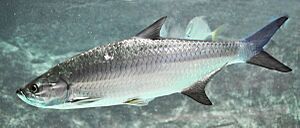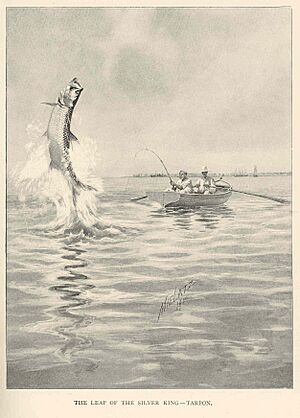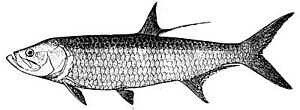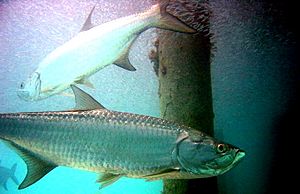Atlantic tarpon facts for kids
Quick facts for kids Atlantic tarpon |
|
|---|---|
 |
|
| Conservation status | |
| Scientific classification | |
| Genus: |
Megalops
|
| Species: |
atlanticus
|
| Synonyms | |
|
|
The Atlantic tarpon (Megalops atlanticus) is a cool ray-finned fish that lives in coastal waters. You can find them in places where rivers meet the sea, called estuaries and lagoons, and even in rivers. It's also known as the silver king because of its shiny, silver scales!
You can find tarpons in the Atlantic Ocean, mostly in warm, tropical places. But sometimes they swim far north to Nova Scotia or even south to Argentina! Like other fish in its family, it lays its eggs out in the open ocean. They eat small fish and tiny sea creatures like shrimp.
Tarpons are famous for their amazing jumps out of the water. They can grow to an astonishing size and have tough, armored scales. People usually don't eat them because their meat isn't very tasty. However, they are highly valued as a game fish by people who love to fish for fun.
Contents
About the Atlantic Tarpon
Atlantic tarpons are very old fish! They first appeared about 18 million years ago. This makes them one of the oldest living fish species on Earth.
These fish can grow very large. The longest one ever recorded was about 2.5 meters (over 8 feet) long. The heaviest one weighed up to 161 kilograms (about 355 pounds). That's heavier than a small car! Male tarpons usually don't weigh more than 100 pounds.
A special thing about tarpons is that they can breathe air! They can fill their swim bladder with air, almost like a simple lung. This helps them when there isn't much oxygen in the water.
Tarpons are greenish or bluish on top and shiny silver on their sides. They have a big mouth that points upwards. The last ray of their dorsal fin (the fin on their back) is much longer than the others. It almost reaches their tail!
What Tarpons Eat and How They Grow
The Atlantic tarpon's main predators are sharks and humans.
What a tarpon eats changes as it grows up.
- When they are tiny larvae (called leptocephalus), they absorb nutrients directly from the water. They don't even need to eat!
- As young fish (juveniles), they eat tiny water creatures called zooplankton and other small prey.
- Adult tarpons mostly eat fish, crabs, and shrimp.
When they are about three years old, young tarpons move from these calm, shallow areas to different places near the shore. They grow quickly, mostly getting longer. Around eight years old, Atlantic tarpons become adults and can have babies. At this point, they start to get wider as well as longer. Male tarpons grow much slower than females.
Tarpons and People
People have used Atlantic tarpon scales for a long time. In the past, they were used as nail files and for decorations. In some places, like Brazil, crushed tarpon scales are even used in traditional medicine.
Did you know an Atlantic tarpon is shown in a painting on the Sistine Chapel ceiling? The famous artist Michelangelo finished this painting around 1510.
The Atlantic tarpon was first described by a scientist named Achille Valenciennes in 1847. He named it Megalops atlanticus. The name Megalops means "large eyes," which fits them well!
The tarpon is the official state saltwater fish of Alabama in the United States.
Atlantic tarpons can live well in cities and towns. This is because they don't mind boat traffic and can handle water that isn't super clean. When they are around people, tarpons are mostly active at night.
Even though people in the United States rarely eat Atlantic tarpon, they are caught for food in some other countries. Both their meat and their eggs (roe) are eaten.
Fishing for Tarpons

Tarpons are considered one of the best saltwater game fishes. This is because they are big, easy to find, and put up a great fight when caught! They are very strong and make amazing leaps into the air. They are the biggest fish that fly fishermen try to catch in shallow water.
As mentioned, their meat is not very good to eat. It's often described as smelly and bony. In places like Florida and Alabama, you need a special permit to keep a tarpon. So, most tarpon fishing there is catch and release, meaning you catch the fish and then let it go. In Texas, they are also a special game fish. Only very large tarpons (over 75 inches) that might set a new state record are allowed to be kept.
English-speaking anglers (fishermen) often call tarpons "The Silver King."
Where Tarpons Live and Travel
Since tarpons are not caught much for food, scientists don't know everything about where they live and how they travel. They live on both sides of the Atlantic Ocean. In the eastern Atlantic, they are found from Senegal to the Congo. In the western Atlantic, they mostly live in the warm coastal waters of the Gulf of Mexico, Florida, and the West Indies. However, fishermen sometimes catch them as far north as Cape Hatteras and Nova Scotia, and as far south as Argentina. In the Gulf of Mexico, there are two different groups of tarpons, separated by the Mississippi River Delta.
Atlantic tarpons travel a lot and often cross international borders. This makes it tricky for different countries to work together to protect them.
Scientists have found that schools of tarpons have been swimming through the Panama Canal from the Atlantic to the Pacific and back for over 80 years! Tarpons can handle different amounts of salt in the water and will eat many things. This means their travels are mostly limited by water temperature. They like water temperatures between 22 to 28 degrees Celsius (72 to 82 degrees Fahrenheit). If the water gets colder than 16 degrees Celsius (61 degrees Fahrenheit), they become very slow. Temperatures below 4 degrees Celsius (39 degrees Fahrenheit) can even kill them.
A large group of tarpons lives in the Rio San Juan and Lake Nicaragua. In the Pacific Ocean, a group of tarpons has made a home in Costa Rica.
Atlantic tarpons gather in large groups in the open ocean to lay their eggs. Baby tarpons, called leptocephali, are unique. They are long and thin and don't eat much because they don't need a lot of energy. While they are larvae, their teeth point forward to keep things out of their mouths.
These larvae grow into young fish (juveniles) that swim closer to shore. They often go into still water with very little oxygen. Most of their predators can't live in these low-oxygen areas, which helps the young tarpons stay safe.
See also
- Flats fishing
- Indo-Pacific tarpon
- Milkfish




